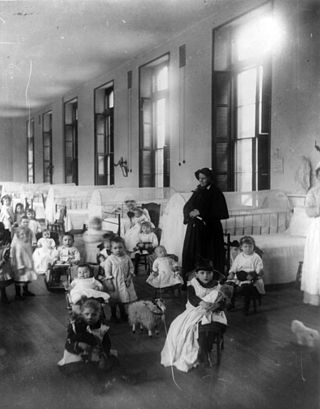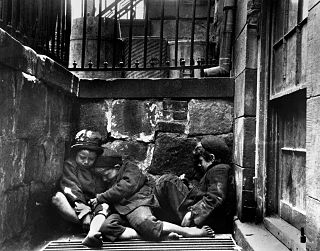Related Research Articles

Adoption is a process whereby a person assumes the parenting of another, usually a child, from that person's biological or legal parent or parents. Legal adoptions permanently transfer all rights and responsibilities, along with filiation, from the biological parents to the adoptive parents.
Filiation is the legal term for the recognized legal status of the relationship between family members, or more specifically the legal relationship between parent and child. As described by the Government of Quebec:
Filiation is the relationship which exists between a child and the child’s parents, whether the parents are of the same or the opposite sex. The relationship can be established by blood, by law in certain cases, or by a judgment of adoption. Once filiation has been established, it creates rights and obligations for both the child and the parents, regardless of the circumstances of the child’s birth.
International adoption is a type of adoption in which an individual or couple residing in one country becomes the legal and permanent parent(s) of a child who is a national of another country. In general, prospective adoptive parents must meet the legal adoption requirements of their country of residence and those of the country whose nationality the child holds.
Emancipation of minors is a legal mechanism by which a minor before attaining the age of majority is freed from control by their parents or guardians, and the parents or guardians are freed from responsibility for their child. Minors are normally considered legally incompetent to enter into contracts and to handle their own affairs. Emancipation overrides that presumption and allows emancipated children to legally make certain decisions on their own behalf.

More adoptions occur in California each year than any other state. There is domestic adoption, international adoption, step parent adoption and adult adoption.
In the United States, adoption is the process of creating a legal parent–child relationship between a child and a parent who was not automatically recognized as the child's parent at birth.
Parental responsibility refers to the responsibility which underpin the relationship between the children and the children's parents and those adults who are granted parental responsibility by either signing a 'parental responsibility agreement' with the mother or getting a 'parental responsibility order' from a court. The terminology for this area of law now includes matters dealt with as contact and residence in some states. Parental responsibilities are connected to Parents' rights and privileges.

The Adoption and Safe Families Act was signed into law by President Bill Clinton on November 19, 1997, after having been approved by the United States Congress earlier in the month.
Child protective services (CPS) is the name of an agency responsible for providing child protection, which includes responding to reports of child abuse or neglect. Some countries and US states use other names, often attempting to reflect more family-centered practices, such as department of children and family services (DCFS). CPS is also sometimes known by the name of department of social services, though these terms more often have a broader meaning.

The Indian Child Welfare Act of 1978 is a United States federal law that governs jurisdiction over the removal of American Indian children from their families in custody, foster care and adoption cases.
In the United States, Child and Family Services Reviews (CFSR) are conducted by the federal Children's Bureau, within the United States Department of Health and Human Services, to help states improve safety, permanency and well-being outcomes for children and families who receive services through the child welfare system. The Bureau conducts the reviews to ensure conformity with federal child welfare requirements, to determine what is actually happening to children and families in child welfare services, and to assist states in helping children and families achieve positive outcomes. The CFSRs monitor States' conformity with the requirements of title IV-B of the Social Security Act. The first round of reviews took place between 2000 and 2004 and the second round took place between 2007 and 2010. In both rounds, all States were required to implement Program Improvement Plans (PIPs) as part of the review process. The third round of CFSRs took place between 2015 and 2018; a complete aggregate report of those findings has yet to be released.
Adoption in France is codified in the French Civil Code in two distinct forms: simple adoption and plenary adoption.

The Florida Department of Children and Families (DCF) is a state agency of Florida. Its headquarters are at 2415 North Monroe St., Ste. 400 in Tallahassee, Florida. The department provides social services in Florida to children, adults, refugees, domestic violence victims, human trafficking victims, the homeless community, child care providers, disabled people, and the elderly.
The following outline is provided as an overview of and topical guide to adoption:
Until 2017, laws related to LGBTQ+ couples adopting children varied by state. Some states granted full adoption rights to same-sex couples, while others banned same-sex adoption or only allowed one partner in a same-sex relationship to adopt the biological child of the other.

Foster care is the term used for a system in which a minor who has been made a ward or a non-minor, typically aged 18–21, who volunteers for placement, is placed in a relative placement, a non-related extended family (NREFM) placement, a community family home, an institution, a group home (residential child care community, residential treatment center, etc. Relative, NREFM, and community caregivers certified by the state are typically referred to as "foster parents," "kin caregivers," "resource parents," or other local terms. The placement of the child is usually arranged through state or county social services. The institution, group home, or caregiver is reimbursed for the expenses related to caring for the child. The state via the family court and child protection agency stand in loco parentis to the minor, making all legal decisions, while the caregiver is responsible for the day-to-day care of the minor. Even while their child is in Care, typically birth parents retain Education and Medical rights and the right to contact with their child unless parental rights are terminated by the Court.
Adoptive Couple v. Baby Girl, 570 U.S. 637 (2013), was a decision of the Supreme Court of the United States which held that several sections of the Indian Child Welfare Act (ICWA) do not apply to Native American biological fathers who are not custodians of a Native American child. The court held that the procedures required by the ICWA to end parental rights do not apply when the child has never lived with the father. Additionally, the requirement to make extra efforts to preserve the Native American family also does not apply, nor is the preferred placement of the child in another Native American family required when no other party has formally sought to adopt the child.

Adoption in the Philippines is a process of granting social, emotional and legal family and kinship membership to an individual from the Philippines, usually a child. It involves a transfer of parental rights and obligations and provides family membership. The Department of Social Welfare and Development (DSWD) defines adoption as a "socio-legal process of giving a permanent family to a child whose parents have voluntarily or involuntarily given up their parental rights."

The Preventing Sex Trafficking and Strengthening Families Act is a US bill that would address federal adoption incentives and would amend the Social Security Act (SSA) to require the state plan for foster care and adoption assistance to demonstrate that the state agency has developed policies and procedures with respect to the children it is working, and which are (possibly) a victim of sex trafficking or a severe form of trafficking in persons. The bill furthermore requires states to implement the 2008 UIFSA version, which is required so the 2007 Hague Maintenance Convention can be ratified by the US.
The second-parent adoption or co-parent adoption is a process by which a partner, who is not biologically related to the child, can adopt their partner's biological or adoptive child without terminating the first legal parent's rights. This process is of interest to many couples, as legal parenthood allows the parent's partner to do things such as: make medical decisions, claim dependency, or gain custody in the event of the death of the biological parent.
References
- ↑ Conn. Gen. Stat. § 45a-707(a)(2007).
- ↑ Conn. Gen. Stat. § 45a-706.
- ↑ Killen v. Klebanoff, 140 Conn 111, 115 (1953).
- 1 2 3 Adoption and Foster Care: Statistics and Recent Legislation, OLR Research Report, available at http://www.cga.ct.gov/2006/rpt/2006-R-0684.htm.
- ↑ Conn. Regs. §8-210b-9a.
- ↑ A "group home" is a non-secure home licensed by DCF for children.
- ↑ "Medical care" refers to those children living in short-term residential programs "cooling off" from a particular crisis.
- ↑ "SAFE" homes are temporary homes used by DCF to place children traumatized by abuse and neglect. Children may spend up to 45 days there while DCF assesses their needs and searches for appropriate placement.
- ↑ In re Theresa S., 196 Conn. 18, 30, 491 A. 2d 355 (1985).
- 1 2 3 Conn. Gen. Stat. § 45a-715 (2007)
- ↑ 209 Conn. 407, 551 A.2d 738 (1988)